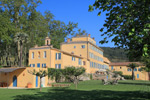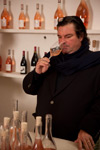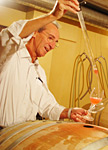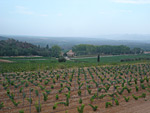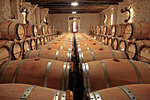Fine and Traditional Absinthes from Alexander Hadleigh
THE HISTORY OF ABSINTHE
Absinthe takes its name from Artemisia absinthium, the botanical name for the bitter wormwood , known in french as “Grande absinthe”. This ingredient of the liquor absinthe also contains the molecule thujone, which supposedly accounts for its alleged mind altering properties. Wormwood infusions had been known as a medicine as far back as Greek times however it was not until around 1792 that the alcohol elixir was supposedly created. Pierre Ordinaire, a French Doctor living in Switzerland, distilled the wormwood plant in alcohol with anise, hyssop, lemon balm and other local herbs. According to popular legend,Ordinaire actually obtained his recipe from the local Henriod sisters, who had been making an ” elixir d’absynthe” to treat illnesses for years. The tonic, quite powerful at around 72% alcohol, was locally heralded as a medical cure-all. The recipe was in turn passed on to a Major Dubied, whose son-in -law was Henri-Louis Pernod. What ever the truth behind its origins, absinthe stopped being a local curiosity and started on its route to becoming an international phenomenon in 1797 with the foundation of their new distillery in Couvet, Switzerland. In 1805, the famous Pernod Fils distillery expanded and opened in Pontarlier, France to avoid customs taxes between Switzerland and France. By 1905, there were hundreds of distilleries in all corners of France producing absinthe, with over 40 distilleries operating across the Swiss border in the French Jura region, 22 of which were located within the town of Pontarlier, itself producing 7,000,000 litres a year from 151 stills. The success of the highly regarded Pontarlier brands brought many imitators and profiteers soon introduced cheaper, adulterated and even poisonous imitations onto the market that were in turn partially responsible for the reputation that absinthe gained for causing delirium and madness in those who drank it.
Originally, absinthe gained its popularity from its use in North Africa during the French campaignes of the 1840’s as a disease preventative and water purifier. The French soldiers brought their taste for the herbal beverage back to the cafes of Paris. Here it became a fashionable drink of the bourgeoisie, so much so that the time between 5.00pm and 7.00pm became known as “l’heure verte” (the Green Hour), and absinthe soon became the most popular aperitif in France. From the mid 19th Century onwards absinthe became associated with bohemian Paris and featured frequently in the paintings of such artists as Manet, Van Gogh and Picasso. When they were not painting it, they were drinking it in large quantities, joined by contempory poets such as Baudelaire, Rimbaud and Verlaine – who practically made a career out of it. Absinthe production grew so much that it became cheaper than wine. Between 1876 and 1900 the annual consumption in France had rocketed from 1,000,000 litres to 21,000,000 litres. It is no exaggeration to compare the impact of banning absinthe to the effect that the banning of Scotch Whisky would have on Scotland.
So, if absinthe was so popular, why was it banned? there were a number of reasons. It got caught up in the temperance movement that was sweeping Europe at the beginning of the 20th Century and became the scapegoat for all alcohol; findings were published shwing that thujone was a neurtoxin in extremely large quantities (albiet more than was found in even 150 glasses of absinthe) which caused convulsions and death in laboratory animals. Pressure also came from the wine producers who saw its popularity as a threat to their sales, which had been badly hit by the spread of the phylloxera louse that destroyed most of France’s vineyards by 1890. Another nail was driven in the coffin with the lurid ‘Absinthe Murder’ which took place in Switzerland in 1905 when one monsieur Lanfray shot his entire family after drinking absinthe. The fact that he had also consumed several litres of wine and a considerable amount of brandy was overlooked by the prohibitionists and by 1910 absinthe was banned in Switzerland. The constant bad press came from across the Atlantic and an anti-absinthe novel titled “Wormwood, a drama of Paris” penned by Marie Corelli ( who would be considered the Belle Epoque Danielle Steele) caused a furor in the United States. Absinthe was mostly consumed in ‘cosmopolitan’ cities like San Francisco, New Orleans, Chicago and New York and the scandalous stories that spread across the American heartland prompted its banning nationwide in 1912. Finally , in 1915, absinthe was banned in France, but it took a military order to do it.
Contrary to popular belief, absinthe was never banned in the United Kingdom, Spain or Portugal.
Some of our collection of Absinthe for you to savoir
Absinthe Brevans, Matter-Luginbuhl, Switzerland ![]()
![]() Absinthe Clandestine, Claude Alain Bugnon, Switzerland
Absinthe Clandestine, Claude Alain Bugnon, Switzerland
![]() Absinthe La Coquette, Paul Devoille, France
Absinthe La Coquette, Paul Devoille, France
![]() Absinthe La Fee Bohemian, Czech Republic
Absinthe La Fee Bohemian, Czech Republic
Absinthe Montmarte, Fischer, Austria

HAPPY ABSINTHE DAYS
DEL
 Comments Off on Fine and Traditional Absinthes from Alexander Hadleigh
Comments Off on Fine and Traditional Absinthes from Alexander Hadleigh 





